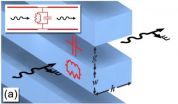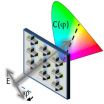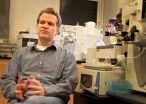(Press-News.org) PHILADELPHIA -- The technological world of the 21st century owes a tremendous amount to advances in electrical engineering, specifically, the ability to finely control the flow of electrical charges using increasingly small and complicated circuits. And while those electrical advances continue to race ahead, researchers at the University of Pennsylvania are pushing circuitry forward in a different way, by replacing electricity with light.
"Looking at the success of electronics over the last century, I have always wondered why we should be limited to electric current in making circuits," said Nader Engheta, professor in the electrical and systems engineering department of Penn's School of Engineering and Applied Science. "If we moved to shorter wavelengths in the electromagnetic spectrum — like light — we could make things smaller, faster and more efficient."
Different arrangements and combinations of electronic circuits have different functions, ranging from simple light switches to complex supercomputers. These circuits are in turn built of different arrangements of circuit elements, like resistors, inductors and capacitors, which manipulate the flow of electrons in a circuit in mathematically precise ways. And because both electric circuits and optics follow Maxwell's equations — the fundamental formulas that
describe the behavior of electromagnetic fields — Engheta's dream of building circuits with light wasn't just the stuff of imagination. In 2005, he and his students published a theoretical paper outlining how optical circuit elements could work.
Now, he and his group at Penn have made this dream a reality, creating the first physical demonstration of "lumped" optical circuit elements. This represents a milestone in a nascent field of science and engineering Engheta has dubbed "metatronics."
Engheta's research, which was conducted with members of his group in the electrical and systems engineering department, Yong Sun, Brian Edwards and Andrea Alù, was published in the journal Nature Materials.
In electronics, the "lumped" designation refers to elements that can be treated as a black box, something that turns a given input to a perfectly predictable output without an engineer having to worry about what exactly is going on inside the element every time he or she is designing a circuit.
"Optics has always had its own analogs of elements, things like lenses, waveguides and gratings," Engheta said, "but they were never lumped. Those elements are all much larger than the wavelength of light because that's all that could be easily built in the old days. For electronics, the lumped circuit elements were always much smaller than the wavelength of operation, which is in the radio or microwave frequency range."
Nanotechnology has now opened that possibility for lumped optical circuit elements, allowing construction of structures that have dimensions measured in nanometers. In this experiment's case, the structure was comb-like arrays of rectangular nanorods made of silicon nitrite.
The "meta" in "metatronics" refers to metamaterials, the relatively new field of research where nanoscale patterns and structures embedded in materials allow them to manipulate waves in ways that were previously impossible. Here, the cross-sections of the nanorods and the gaps between them form a pattern that replicates the function of resistors, inductors and capacitors, three of the most basic circuit elements, but in optical wavelengths.
"If we have the optical version of those lumped elements in our repertoire, we can actually make designs similar to what we do in electronics but now for operation with light," Engheta said. "We can build a circuit with light."
In their experiment, the researchers illuminated the nanorods with an optical signal, a wave of light in the mid-infrared range. They then used spectroscopy to measure the wave as it passed through the comb. Repeating the experiment using nanorods with nine different combinations of widths and heights, the researchers showed that the optical "current" and optical "voltage" were altered by the optical resistors, inductors and capacitors with parameters corresponding to those differences in size.
"A section of the nanorod acts as both an inductor and resistor, and the air gap acts as a capacitor," Engheta said.
Beyond changing the dimensions and the material the nanorods are made of, the function of these optical circuits can be altered by changing the orientation of the light, giving metatronic circuits access to configurations that would be impossible in traditional electronics.
This is because a light wave has polarizations; the electric field that oscillates in the wave has a definable orientation in space. In metatronics, it is that electric field that interacts and is changed by elements, so changing the field's orientation can be like rewiring an electric circuit.
When the plane of the field is in line with the nanorods, as in Figure A, the circuit is wired in parallel and the current passes through the elements simultaneously. When the plane of the electric field crosses both the nanorods and the gaps, as in Figure B, the circuit is wired in series and the current passes through the elements sequentially.
"The orientation gives us two different circuits, which is why we call this 'stereo-circuitry,'" Engheta said. "We could even have the wave hit the rods obliquely and get something we don't have in regular electronics: a circuit that's neither in series or in parallel but a mixture of the two."
This principle could be taken to an even higher level of complexity by building nanorod arrays in three dimensions. An optical signal hitting such a structure's top would encounter a different circuit than a signal hitting its side. Building off their success with basic optical elements, Engheta and his group are laying the foundation for this kind of complex metatronics.
"Another reason for success in electronics has to do with its modularity," he said. "We can make an infinite number of circuits depending on how we arrange different circuit elements, just like we can arrange the alphabet into different words, sentences and paragraphs.
"We're now working on designs for more complicated optical elements," Engheta said. "We're on a quest to build these new letters one by one."
INFORMATION:
This work was supported in part by the U.S. Air Force Office of Scientific Research.
Andrea Alù is now an assistant professor at the University of Texas at Austin.
Penn researchers build first physical 'metatronic' circuit
2012-02-24
ELSE PRESS RELEASES FROM THIS DATE:
SEAT Reveals the New Five Door Mii City Car
2012-02-24
SEAT is revealing an expansion to the Mii city car line-up with the first glimpse of an even more versatile five-door version.
The additional rear doors turn the super-compact SEAT into a unique combination of exceptional driving fun, sporty design and outstanding functionality.
Of course the new five-door Mii remains true to core SEAT principles - meaning it's both a pleasure to drive, and a pleasure to own.
In either three- or five-door form the Mii scores top marks for fuel consumption and emissions thanks to its lightweight design and efficient drivetrains. ...
Genome sequencing finds unknown cause of epilepsy
2012-02-24
Only 10 years ago, deciphering the genetic information from one individual in a matter of weeks to find a certain disease-causing genetic mutation would have been written off as science fiction.
It was the time of the Human Genome Project, and it had taken armies of sequencing robots working around the clock for almost a decade to unravel the complete sequence of the human genetic code – referred to as the genome – by churning out the DNA alphabet letter by letter.
Now a team headed by Michael Hammer from the University of Arizona applied Next Generation Genome Sequencing ...
HotRussianBrides.com and RussianLoveMatch.com to Stream Live Beauty Pageant from Odessa, Ukraine on February 25
2012-02-24
Russian dating websites HotRussianBrides.com and RussianLoveMatch.com announced that both will live stream "Precious Pearl", a beauty pageant taking place in Odessa, Ukraine on February 25, 2012 at approximately 12:30pm Eastern Time.
Complete with choreographed dance numbers, a talent segment, and a fashion segment, the pageant will feature single Ukrainian women from around the country, all vying to be crowned Miss Precious Pearl. The event is coordinated by a local dating agency affiliate based in Odessa with branches all over Ukraine. This is the second ...
Naked mole-rats bear lifesaving clues
2012-02-24
Could blind, buck-toothed, finger-sized naked mole-rats harbor in their brain cells a survival secret that might lead to better heart attack or stroke treatments?
University of Illinois at Chicago biologist Thomas Park and colleagues at UIC and the University of Texas Heath Science Center at San Antonio think the subterranean lifestyle of the pasty-looking rodents may indeed hold clues to keeping brain cells alive and functioning when oxygen is scarce. The key may lie in how brain cells regulate their intake of calcium.
"Normally, calcium in brain cells does wonderful ...
A rainbow for the palm of your hand
2012-02-24
BUFFALO, N.Y. -- University at Buffalo engineers have developed a one-step, low-cost method to fabricate a polymer with extraordinary properties: When viewed from a single perspective, the polymer is rainbow-colored, reflecting many different wavelengths of light.
Used as a filter for light, this material could form the basis of handheld multispectral imaging devices that identify the "true color" of objects examined. An image of the material is available here: http://www.buffalo.edu/news/13214.
"Such portable technology could have applications in a wide range of fields, ...
Track and Field News: Felix Sanchez Sets Indoor World Record in Two Consecutive Races
2012-02-24
Felix Sanchez (also known as El Super Sanchez) is one of the most decorated 400m Hurdlers in history. To his name, he already has an Olympic Gold Medal, 2 Outdoor World Championships, 2 Pan American Championships and numerous other accolades. This past week, the 34 year old Sanchez made history again by breaking the Indoor World Record in two consecutive races by nearly half a second in each race.
The previous World Record of 49.73 seconds was set in 2010 by Sanchez as well. On February 4th, Sanchez competed in Mondeville, France, finishing his race in 49.25 seconds, ...
Metal nanoparticles shine with customizable color
2012-02-24
Cambridge, Mass. - February 23, 2012 – Engineers at Harvard have demonstrated a new kind of tunable color filter that uses optical nanoantennas to obtain precise control of color output.
Whereas a conventional color filter can only produce one fixed color, a single active filter under exposure to different types of light can produce a range of colors.
The advance has the potential for application in televisions and biological imaging, and could even be used to create invisible security tags to mark currency. The findings appear in the February issue of Nano Letters.
Kenneth ...
Whittard of Chelsea Releases Perfect 'Cuppa' Guide Ahead of Bumper Tea-Making Day - Mothering Sunday
2012-02-24
The UK Tea Council expects more than 165 million cups of tea to be drunk in the UK this Mothering Sunday. As the annual homage to Mothers approaches, millions of sons and daughters around the country are planning to serve breakfast in bed including the ultimate 'cuppa' for the celebrated women in their lives. Tea and coffee specialists Whittard of Chelsea, who have already identified a pre-Mother's Day tea selling surge, have today released their expert guide to making the perfect cuppa.
Every year, Whittard of Chelsea monitors the Mother's Day effect, estimated to be ...
Blood mystery solved
2012-02-24
You probably know your blood type: A, B, AB or O. You may even know if you're Rhesus positive or negative. But how about the Langereis blood type? Or the Junior blood type? Positive or negative? Most people have never even heard of these.
Yet this knowledge could be "a matter of life and death," says University of Vermont biologist Bryan Ballif.
While blood transfusion problems due to Langereis and Junior blood types are rare worldwide, several ethnic populations are at risk, Ballif notes. "More than 50,000 Japanese are thought to be Junior negative and may encounter ...
Healthy foods missing from stores in low-income black neighborhoods, UGA study finds
2012-02-24
Athens, Ga. – Most convenience stores have a wide variety of chips, colorful candies and bottles of sugar-sweetened carbonated beverages. While shoppers can buy calorie-heavy foods wrapped in pretty packages in these locations, what they usually can't find are the fresh produce, whole grains and low-fat dairy products necessary for a healthy diet.
These stores are the only nearby food source for millions of Americans living in what are called food deserts, because they are isolated from affordable healthy food. In recent studies, University of Georgia foods and nutrition ...






